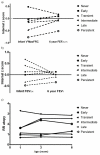Validation of novel wheeze phenotypes using longitudinal airway function and atopic sensitization data in the first 6 years of life: evidence from the Southampton Women's survey
- PMID: 23401430
- PMCID: PMC3689612
- DOI: 10.1002/ppul.22766
Validation of novel wheeze phenotypes using longitudinal airway function and atopic sensitization data in the first 6 years of life: evidence from the Southampton Women's survey
Abstract
Background: In 1995 the Tucson Children's Respiratory Study (TCRS) identified clinically distinct phenotypes amongst early wheezers; the Avon Longitudinal Study of Parents And Children (ALSPAC) has recently re-examined these.
Objectives: To validate statistically derived ALSPAC phenotypes in the Southampton Women's Survey (SWS) using infant and 6-year lung function, and allergic sensitization at 1, 3, and 6 years, comparing these with TCRS phenotypes.
Methods: Complete 6-year follow-up data were available for 926 children, selected from 1,973 infants born to 12,579 women characterized pre-conception. Ninety-five children had V'maxFRC and FEV0.4 measured age 5-14 weeks using rapid compression/raised volume techniques. At 6 years we performed spirometry (n = 791), fractional exhaled nitric oxide (FeNO, n = 589) and methacholine challenge (n = 234). Skin prick testing was performed at 12m, 3 and 6 years (n = 1,494, 1,255, 699, respectively). Using wheeze status questionnaire data at 6m, 12m, 2, 3 and 6 years we classified children into TCRS (never, transient early, persistent, late-onset) and ALSPAC based groups (never, early, transient, intermediate-onset, late-onset, persistent).
Results: Amongst ALSPAC groups, persistent and late-onset wheeze were associated with atopy at 3 and 6 years, whilst intermediate-onset wheeze showed earlier atopic association at 1 year; all three were associated with FeNO at 6 years. Persistent wheezers had lower infant (V'maxFRC P < 0.05) and 6-year lung function (FEV1, FEV1/FVC, and FEF(25-75), P < 0.05), whilst late and intermediate-onset wheezers showed no lung function deficits. Transient wheezers were non-atopic but showed persistent lung function deficits (V'maxFRC in infancy, FEV1 and FEF(25-75) at 6 years, all P < 0.05). Those who wheezed only in the first year (early phenotype) showed no lung function deficits. No associations were seen with 6 years bronchial hyper-responsiveness or infancy FEV0.4.
Conclusion: SWS cohort data validates the statistically derived ALSPAC six-class model. In particular, lung function and atopy successfully differentiate persistent, late-onset and intermediate-onset wheeze, whilst the Tucson "transient early" wheeze phenotype can be sub-classified into groups that reflect early lung function. Since the 4-class model fails to adequately differentiate phenotypes based on lung function and atopy, we propose that strong consideration be given to using the 6-class paradigm for longitudinal outcome work in wheezing with onset in early life.
Copyright © 2013 Wiley Periodicals, Inc.
Figures



References
-
- Martinez FD, Wright AL, Taussig LM, et al. The Group Health Medical Associates Asthma and wheezing in the first six years of life. N Engl J Med. 1995;332:133–8. - PubMed
-
- Sandin A, Björkstén B, Bråbäck L. Development of atopy and wheezing symptoms in relation to heredity and early pet keeping in a Swedish birth cohort. Pediatr Allergy Immunol. 2004;15:316–22. - PubMed
-
- Kurukulaaratchy RJ, Fenn M, Twiselton R, et al. The prevalence of asthma and wheezing illnesses amongst 10-year-old schoolchildren. Respir Med. 2002;96:163–9. - PubMed
-
- Illi S, von Mutius E, Lau S, et al. Perennial allergen sensitisation early in life and chronic asthma in children: a birth cohort study. Lancet. 2006;368:763–70. - PubMed
-
- Brussee JE, Smit Ha, van Strien RT, et al. Allergen exposure in infancy and the development of sensitization, wheeze, and asthma at 4 years. J Allergy Clin Immunol. 2005;115:946–52. - PubMed
Publication types
MeSH terms
Grants and funding
LinkOut - more resources
Full Text Sources
Other Literature Sources
Medical

